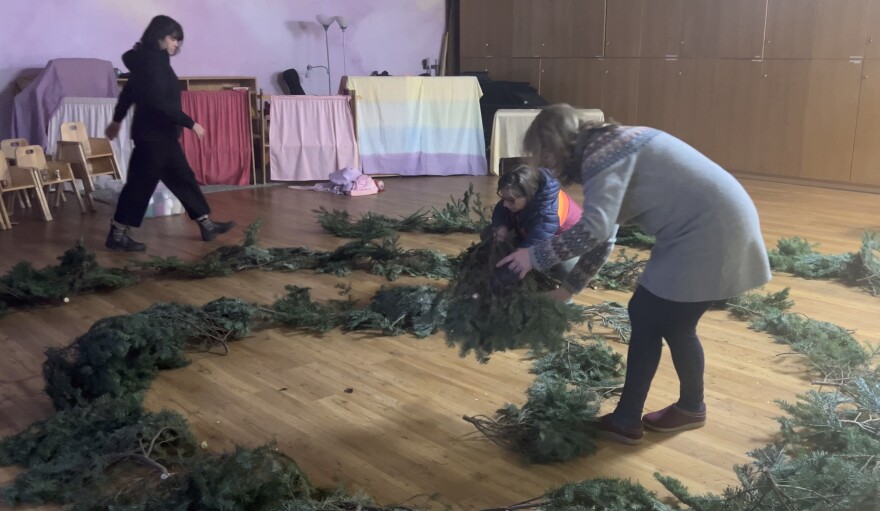With so many days of darkness, it’s easy to see why the winter solstice is so important to Alaskans. As the shortest day of the year, with the longest night, it signals the return towards more light.
At the Anchorage Waldorf School, the days that lead up to the solstice are a busy time.

During recess, the third graders have taken advantage of heavy snowfall to dig out several snow caves.As Elliah Middleton burrowed into one, she said, “I am a bear, and I am hibernating.”
Kids intuitively know that winter is a time when the earth is asleep under a heavy blanket of snow, and unlike adults are quick to find the magic of this dark and cold time of the year.
It’s a period when the teachers give children lessons and art projects that explore the nature of darkness and light, from both a scientific and spiritual perspective.
Waldorf schools, which encourage a reverence for nature, use this time of the year to tap into that sense of wonder.
Watch Video: Waldorf Winter Spiral Walk
“It’s a way, I believe, for the children to internally connect with holding up the light themselves,” said Shenandoah Herda, who teaches eighth grade at the school.

This year her students have been making a stained glass lantern, with help from Hans Schepker, a visiting artist and math teacher. He’s chosen a design based on a spiral named for the Greek philosopher Theodorus, one of many different kinds of spirals.
“They all start somewhere and get to the center,” Schepker says, “but in different ways.”
He says the Theodorus spiral is made up of right angles, aligned edge to edge, which makes a geometric form in the shape of a snail.
“They can do many math lessons around this,” he said.
But the end result will be a beautiful lantern shaped by pieces of glass cut into triangles that grow incrementally, based on the Pythagorean Theorem.

For Herda, the lantern project has other dimensions.
“From very ancient times, spirals have had a sense of beauty around them, a sense of proportion and mathematical symmetry to them,” Herda said.
For the school, the spiral is an important symbol of solstice, because it mirrors the soul’s journey inward into the darkness and back into the light — a journey that the whole school experiences together, one that begins in secret when teachers close off a room to lay out boughs of freshly-cut spruce to form a big spiral.

The children are given very little in the way of explanation about the thinking behind the spiral walk, but there are a few hints to build anticipation. Each child receives an apple that they are asked to polish. They are then carved out to hold a beeswax candle, which they are told will be a part of the solstice ceremony.

“The gift of giving the children something that's whole is one where they see the whole beauty of it,” Herda said. “They may not understand the preparation for it, and they don't need to. They experience it as a gift given to them during this darkest time, as a gift of beauty.”
Some Waldorf teachers compare the winter season to childbirth, where the baby grows in the darkness of the womb.
Herda says the preparations for the labyrinth, which are hidden out of view, are a similar process.
After the teachers cover the blackboards and the windows, they begin to lay out the boughs, leave little treasures amongst them like gold stars and seashells. The teachers also place candles throughout the spiral -- and at the very center, there’s a larger candle set upon a tree stump.
The end result is a work of living art that greets the children and their families, along with the sounds of gentle harp music and the scent of spruce, which fills a room that is almost completely dark, except for the glow of candles that trace the spiral.

One by one, each child makes a journey to the center of the spiral, lights their candle and places it somewhere within the spiral on their way out.
No child does it the same way. While some race to the center of the spiral, others walk very slowly and carefully with trepidation.
“The gift of the Winter Spiral is one of courage, holding on to our own individual light,” Herda said, “sharing that individual light with others as a community, implicitly giving to our children the understanding that they are not alone, that yes, they are powerful as individuals, but that they can contribute to a greater good.
As each child adds a candle to the spiral, the room grows brighter, a message that Phoebe Fisher, a third grader, took to heart.

“We are each one light and if we stick together, we can each become one bigger light,” said Phoebe, who admitted she was a little nervous starting out. “I think the best part was probably watching all my friends do it. I think it’s really beautiful to see what others do.”
After the ceremony, the candles are blown out and the spiral of spruce lives only in memory -- yet there is hope that each child will still carry their own light into the solstice and beyond.
“I hope that one of the last thoughts that this spiral festival leaves people with is one of hope, hope for the future,” Herda said, “hope that yes, we can make a difference.”


